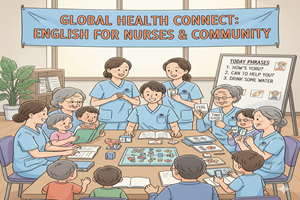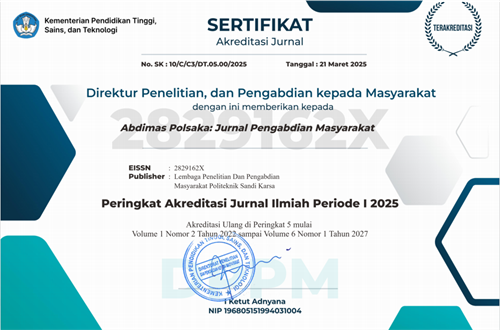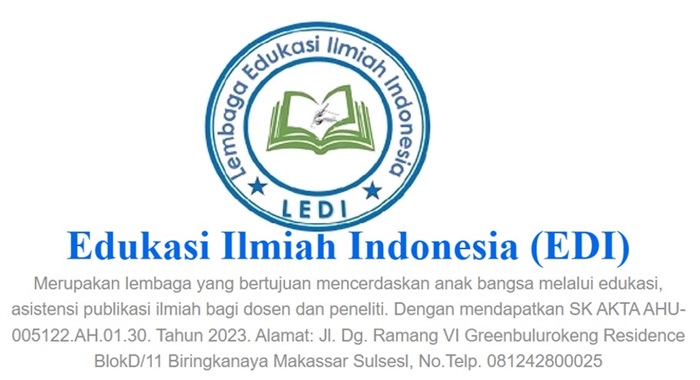Role-play as a community service strategy to improve english communication for nursing students
DOI:
https://doi.org/10.35816/abdimaspolsaka.v4i2.119Keywords:
communication, English, nursing students, role play, trainingAbstract
Communication skills in English are an essential competency for nursing students to face the challenges of globalization and international healthcare services. However, many students still struggle to express themselves confidently in real clinical contexts. This community service program aimed to enhance the communication ability of nursing students through English training using the role-play method. The training was conducted with final-year nursing students at Politeknik Sandi Karsa and applied a participatory approach consisting of lectures, demonstrations, role play simulations, group discussions, and reflective evaluations. Various clinical scenarios were designed, such as explaining medication usage, calming anxious patients, and describing vital sign procedures. The program was implemented over two days, with the first day focusing on interactive material delivery and facilitator demonstrations, while the second day emphasized practical role-play performance with direct feedback. A total of 23 students participated actively in this activity. The results indicated a significant improvement in students’ confidence and ability to use English in professional healthcare communication. Participants expressed positive responses toward the method, highlighting that role play reduced speaking anxiety, increased motivation, and fostered readiness for real clinical interactions. The Focus Group Discussion (FGD) confirmed that this method not only improved English proficiency but also enhanced soft skills such as empathy, teamwork, and therapeutic communication. The outcomes suggest that role–play–based English training is an effective strategy to support nursing education and should be integrated regularly into the curriculum to prepare graduates for global healthcare demands
Downloads
References
E. Ramezanzade Tabriz, M. Sadeghi, E. Tavana, H. Heidarian Miri, and F. Heshmati Nabavi, “Approaches for boosting self-confidence of clinical nursing students: A systematic review and meta-analysis,” Heliyon, vol. 10, no. 6, p. e27347, 2024, DOI: https://doi.org/10.1016/j.heliyon.2024.e27347
A. Ghimire and Y. Qiu, “Redefining pedagogy with artificial intelligence: How nursing students are shaping the future of learning,” Nurse Educ. Pract., vol. 84, p. 104330, 2025, DOI: https://doi.org/10.1016/j.nepr.2025.104330
L. Andreassen, S. A. Steindal, J. Sarin, and B. S. Strøm, “Undergraduate nursing students’ experiences during international clinical placement: A scoping review,” Int. J. Nurs. Stud. Adv., vol. 9, p. 100378, 2025, DOI: https://doi.org/10.1016/j.ijnsa.2025.100378
N. Albrecht, S. K. Franzke, M. Baum, and R. Isidor, “Rebel, reverse, or relent: How female entrepreneurs develop communication strategies on social media to handle gender role stereotypes,” Eur. Manag. J., 2025, DOI: https://doi.org/10.1016/j.emj.2025.07.002
M. Yen, T. (Fung) Koo, K. Sattarshetty, D. Doan, and E. Alsharaydeh, “International graduate entry nursing students: A qualitative study on engagement,” Nurse Educ. Pract., vol. 77, p. 103971, 2024, DOI: https://doi.org/10.1016/j.nepr.2024.103971
A. Chambers and C. Whitfield, “Factors influencing postgraduate nursing students’ engagement with online learning in higher education: A mixed methods literature review,” Nurse Educ. Pract., vol. 88, p. 104570, 2025, DOI: https://doi.org/10.1016/j.nepr.2025.104570
T. B. Wube, S. G. Asgedom, D. G. Abrha, and L. G. Gebrekirstos, “Reproductive health services utilization and associated factors among university youth students in Ethiopia: A mixed-methods study,” Glob. Epidemiol., vol. 9, p. 100195, 2025, DOI: https://doi.org/10.1016/j.gloepi.2025.100195
P. Moyo, M. Podham, S. Dywili, K. Montgomery, and J. Biles, “Exploring international undergraduate nursing students’ experiences and perceptions of campus classes in higher education: A scoping review,” Teach. Learn. Nurs., vol. 20, no. 1, pp. e125–e131, 2025, DOI: https://doi.org/10.1016/j.teln.2024.08.020
Y. T. Wijayanti, D. Nurhanifah, A. S. Asmi, S. Suprapto, R. Rahagia, and R. Millati, “Perception of Nursing Students on Clinical Teaching and Learning of Public Health Nurses: A Descriptive Qualitative Approach,” Malaysian J. Nurs., vol. 16, no. 04, pp. 142–151, Apr. 2025, DOI: https://doi.org/10.31674/mjn.2025.v16i04.014
D. Procter, K. McCullough, D. Massey, and K. Strickland, “Understanding perceptions, attitudes and experiences of nursing students during clinical placement in primary health care settings – A scoping review,” Nurse Educ. Pract., vol. 86, p. 104434, 2025, DOI: https://doi.org/10.1016/j.nepr.2025.104434
O. R. Adeboye, S. H. Annesley, L. Young-Murphy, P. J. Greaves, and A. Steven, “Perceptions of care homes as practice learning environments for pre-registration nursing students: A systematic-narrative hybrid literature review,” Nurse Educ. Today, vol. 145, p. 106504, 2025, DOI: https://doi.org/10.1016/j.nedt.2024.106504
X. Zhao, L. Yu, J. Bonnamy, G. Brand, N. Kovach, and M. Huang, “Challenges faced by international nursing students undertaking graduate research: Contemporary issues,” Nurse Educ. Today, vol. 146, p. 106556, 2025, DOI: https://doi.org/10.1016/j.nedt.2024.106556
M. Lambert et al., “Community pharmacists’ role in optimising antibiotic use: The HAPPY PATIENT project to improve dispensing practices in five EU countries,” Res. Soc. Adm. Pharm., vol. 21, no. 8, pp. 597–607, 2025, DOI: https://doi.org/10.1016/j.sapharm.2025.03.064
J. B. Grant, J. Jones, C. Candrian, K. S. Oman, and S. M. Reed, “The role of nursing communication: A critical interpretive synthesis,” Int. J. Nurs. Stud. Adv., vol. 9, p. 100373, 2025, DOI: https://doi.org/10.1016/j.ijnsa.2025.100373
M. Kennedy, L. Bray, H. Saron, and L.-M. Brady, “Scoping communication training in undergraduate children’s nursing programmes: A mixed method study examining delivery methods and content,” Nurse Educ. Pract., vol. 79, p. 104056, 2024, DOI: https://doi.org/10.1016/j.nepr.2024.104056
M. Glarcher and M. Vaismoradi, “Promoting just culture in nursing education: A systematic integrative review on enhancing patient safety,” Nurse Educ. Today, vol. 152, p. 106776, 2025, DOI: https://doi.org/10.1016/j.nedt.2025.106776
H. Zeng, H. Cheng, X. Zhu, F. Lv, Y. Wang, and J. Wang, “‘Warp and weft combined’: A meta-ethnography of nursing students’ experiences participating in geriatric care services,” Geriatr. Nurs. (Minneap)., vol. 64, p. 103410, 2025, DOI: https://doi.org/10.1016/j.gerinurse.2025.103410
E. Coyne et al., “Health professional students’ evaluation of video resources to improve their communication skills: A co-design study,” Nurse Educ. Today, vol. 147, p. 106601, 2025, DOI: https://doi.org/10.1016/j.nedt.2025.106601
S. Thomas, J. Griffiths, G. Saunders, D. Phipps, C. Todd, and P. Lewis, “Exploring the barriers and facilitators to effective communication with people with age-related hearing loss in community pharmacy settings,” Explor. Res. Clin. Soc. Pharm., vol. 19, p. 100573, 2025, DOI: https://doi.org/10.1016/j.rcsop.2025.100573
A. Mirzaei, M. Shahmari, R. Nemati-Vakilabad, M. Ajri-Khameslou, and A. Steven, “Exploring nursing students’ patient safety learning experiences during clinical practice: A qualitative study utilizing the SLERT tool,” Nurse Educ. Today, vol. 155, p. 106873, 2025, DOI: https://doi.org/10.1016/j.nedt.2025.106873
[A. Jessani et al., “Training Socially-Conscious Dentists: Development and Integration of Community Service-Learning in Dental Curricula in Ontario, Canada,” Int. Dent. J., vol. 75, no. 3, pp. 1874–1884, 2025, DOI: https://doi.org/10.1016/j.identj.2025.01.019
L. Kong, E. Briggs, and A. Xyrichis, “What is the effect of different interprofessional education teaching strategies on healthcare professions students’ interprofessional learning outcomes? A systematic narrative review,” Nurse Educ. Pract., vol. 83, p. 104255, Feb. 2025, DOI: https://doi.org/10.1016/j.nepr.2025.104255
S. MacLean, F. Geddes, and K. Carville, “Use of simulation-based education to improve wound care practice amongst registered and nursing students: An integrative review,” Clin. Simul. Nurs., vol. 104, p. 101758, 2025, DOI: https://doi.org/10.1016/j.ecns.2025.101758
Németh, A. Szatmári, A. Siket Újváriné, G. Hideg-Fehér, and M. Zrínyi, “Nursing student volunteerism for marginalized populations: Predictive analysis of influencing factors,” Nurse Educ. Today, vol. 148, p. 106640, 2025, DOI: https://doi.org/10.1016/j.nedt.2025.106640
G. Bulfone et al., “Nursing students’ health literacy skills: A scoping review for driving research,” Int. J. Educ. Res. Open, vol. 7, p. 100379, 2024, DOI: https://doi.org/10.1016/j.ijedro.2024.100379

Additional Files
Published
How to Cite
Issue
Section
License
Copyright (c) 2025 Yuriatson Yuriatson, Rosmiaty Rosmiaty, Anwar Taufiq, Luana Sasabone, Nurliah Nurliah, Kaharto Kaharto

This work is licensed under a Creative Commons Attribution 4.0 International License.
Most read articles by the same author(s)
- Nur Syamsi Norma Lalla, Yuriatson Yuriatson, Layanan Home Care sebagai Upaya Peningkatan Derajat Kesehatan , Abdimas Polsaka: Vol. 1 No. 2 (2022): Abdimas Polsaka: Jurnal Pengabdian Masyarakat
- Riska Sabriana, Rika Riyandani, Rosmiaty Rosmiaty , Pemberdayaan Ibu Hamil Melalui Peningkatan Pengetahuan tentang Pentingnya Gizi dalam Kehamilan untuk Mencegah terjadinya Anemia , Abdimas Polsaka: Vol. 1 No. 1 (2022): Abdimas Polsaka: Jurnal Pengabdian Masyarakat
- Riska Sabriana, Rika Riyandani, Rosmiaty Rosmiaty, Pemberdayaan Pada Ibu Hamil Terhadap Pengetahuan dan Sikap Ibu Mengenai Pemberian ASI Eksklusif , Abdimas Polsaka: Vol. 2 No. 1 (2023): Abdimas Polsaka: Jurnal Pengabdian Masyarakat




















